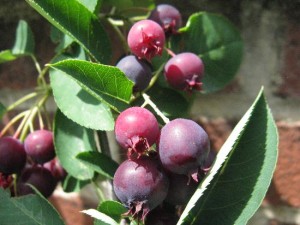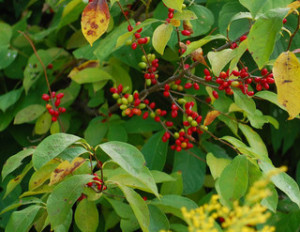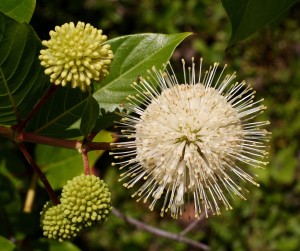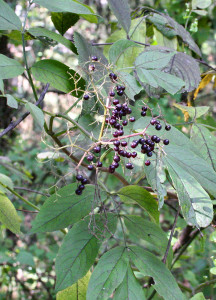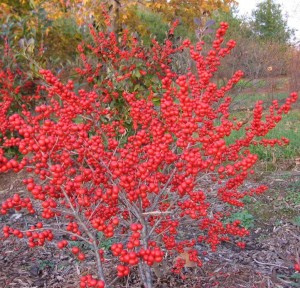March is the time of year when gardeners are just itching to get outside and get their hands dirty. Today I noticed my Honeysuckle leafing out and even saw the buds ready to pop on my Serviceberry. The Red-Winged Blackbirds have been back for a few weeks now, filling up my yard with their O-ka-leeeee call. I know spring is just about here.
Along with the return of many of our favorite birds, spring also means it is time to think about creating or improving your backyard wildlife garden. As more land is lost to development in New Jersey, our backyards will become even more important in the fight to maintain biodiversity in the Garden State. In suburbia a healthy backyard free of pesticides and insecticides along with a good variety of native plants may mean survival for many of our butterflies, migratory birds and pollinators.
A very wise friend of mine once said, “Trying to pick a favorite plant is like trying to pick a favorite grandchild.” It’s just about impossible .“ But since many folks I talk with get a little overwhelmed when trying to pick plants to begin a backyard wildlife garden, I thought I would attempt to pick out a few of my favorites.
Although I realize trying to pick out the best native plants is a touchy issue that is right up there with talking politics and religion, I thought I would take the risk of causing garden brawls all over New Jersey and suggest a few that would work in most New Jersey backyards. Some of the criteria I used to make this tough decision were that the shrub be available , easy to grow and of course be beneficial to wildlife
Serviceberry (Amelanchier) This can be considered a small, multi-stemmed tree or a large shrub. There are a few species available, but the “Canadensis” may be the easiest to find. All of them are great for many species of birds such as Orioles and Scarlet Tanagers. There are a few growing down at DeKorte Park and when the berries are ripe all a birder has to do is to sit on a nearby bench and watch the bird show up. If you feel like a snack after a long day of birding maybe the Orioles will share a few sweet berries with you
Spicebush( Lindera benzoin) This wonderful shrub works in sun or shade and best of all it is the host plant for the Spicebush Swallowtail Butterfly. The female of the plant gets big red berries that are an important source for migratory birds in the fall. It is also a good native substitute for Forsythia as it gets yellow flowers in early spring before the leaves come out. Another bonus is it makes a wonderful tea so it benefits everyone.
Buttonbush (Cephalanthus occidentalis) Buttonbush is our native butterfly bush and it is a magnet for butterflies. Another name for it is Honey balls, as it produces beautiful, sweet smelling white puff ball flowers. In the wild it grows in water but it works in average garden soils as long as you don’t let it dry out for long.
American Elderberry –( Sambucus Canadensis) The beautiful white flowers are followed by large clusters of black little berries that are loved by everything from Flickers to flycatchers. Even butterflies are attracted to its sweet smelling, large masses of flowers. If you have a real deer problem however you may want to stick to my other selections as they love to dine on its sweet leaves and flowers.
Winterberry (Ilex verticillata) I like to call Winterberry the Christmas card shrub. The bright red berries show off against the snow (if the birds don’t get them first). Winterberry grows (depending on the variety) 10-to-15 feet in height. Its tiny white flowers bloom in June; you’ll need at least one male plant to pollinate the female plants to produce berries. Unlike other hollies the leaves are deciduous and its bright red berries cover its bare winter stems that advertise a free meal to every passing bird. American robin, hermit thrush, eastern bluebird, yellow-bellied sapsucker, White-throated sparrow and on and on relish the berries of this wonderful native shrub.
I know many of you are waving your trowels and screaming out your garden windows at this very moment, “What about Dogwoods!” or “ Viburnums!” This is just a small partial list and a starting point and if you let me know what your favorites are we can do a follow up article on the next five favorite shrubs for wildlife. And if you think this caused a ruckus at your last garden club meeting wait until I come up with my favorite five Perennials !
We need to more and more to think of our backyard as a habitat, a place where the birds, butterflies and our children can live healthy lives Dr. Douglas Tallamay, the author of the great book, “Bringing Nature Home,” says we should garden like life depends on it here in New Jersey. There couldn’t be a truer statement .


